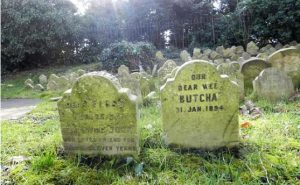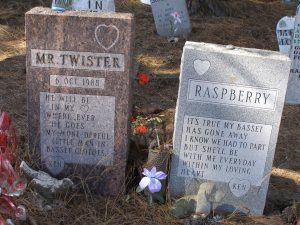Sound archaeological evidence posits that dogs were the first human-bred animal; however, for centuries, they remained valued exclusively for their practicality in labor rather than their companionship (Ault 2016). Researchers today largely agree that modern pet-keeping began in Britain in the late 19th century. As researchers search through the archaeological record, increasing evidence shows that Victorians played a prominent role in reshaping historical opinions on pet ownership and human-animal relationships entirely. Though Victorians felt a level of emotional attachment towards their family pets similar to that in the modern day, their displays of such differ greatly due to societal values and beliefs then held (Ferguson 2019). Yet, as beliefs transformed over time, expressions of both adoration and grief over animals evolved as people began inquiring about the role of pets in the household and the spiritual identity of their animal companions (Tourigny 2020).
In 2020, historical researcher and archaeologist Eric Tourigny conducted a systematic survey on four of Britain’s largest pet cemeteries, analyzing stylistic symbolism and language on gravestones to investigate the change in attitudes and perspectives toward pet animals in addition to how those attitudes reflect the ideals, values, and controversies of particular periods.
Tourigny’s study of Victorian pet gravestones reveals a general initial hesitance toward acknowledging a spiritual essence within animals, observing that many epitaphs display a reluctance or doubt in realizing an animal afterlife similar to that of humans (Tourigny 2020). Some epitaphs, according to Tourigny, are “carefully worded so as only to suggest or hope for reunification in an afterlife”. Moreover, the vocabulary and information included in many epitaphs of earlier gravestones reveal that pets likely occupied a particular role and space within the family unequal to those of their humans (Tourigny 2020). For instance, Tourigny mentions that many Victorian gravestones contain epitaphs strictly referring to animals as “pets”, “companions”, or “friends”, often only listing their behavioral obedient and loyal qualities. Commemorators also rarely included family surnames when referencing their pets (Tourigny 2020). These trends, Tourigny suggests, portray a time in which pets were emotionally valued additions to households but regarded mostly as non-members of the family.
Towards the end of the second world war, perspectives on animal spirituality and household roles began to pivot. As society became increasingly accepting of religious beliefs going into the mid-century, people became comfortable expressing religious affiliation in the memorialization of their pets (Tourigny 2020). References to the afterlife became commonplace, and religious symbolism began to appear in the designs of gravestones (Tourigny 2020). Additionally, Tourigny notes that a sudden increase in the presence of family surnames on gravestones (see Figure 2) insinuates a general acceptance of pets as true members of the family.
Not only does Tourigny’s survey of pet cemeteries aim to understand the transformation of human-animal relationships in recent centuries, but it seeks to understand the influence animals and pet ownership had on initiating transitions in familial, cultural, and societal values. To accomplish this, Tourigny approaches the history of pet ownership through a multi-species archaeological lens by examining how humans have shaped the familial role of pets as well as how pets have inadvertently promoted the individual expression and even re-evaluation of societal beliefs at particular points in history.
To read Eric Tourigny’s research paper, click here.
To read more about Victorian influence on pet-keeping, click here.
References:
Ault, Alicia. “Ask Smithsonian: When Did People Start Keeping Pets?” Smithsonian Magazine. Last modified September 28, 2016. Accessed October 30, 2022.
Ferguson, Donna. “How the Victorians turned mere beasts into man’s best friends.” The Guardian. Last modified October 19, 2019. Accessed October 30, 2022.
Tourigny, Eric. “Do all dogs go to heaven? Tracking human-animal relationships through the archaeological survey of pet cemeteries.” Cambridge Core. Last modified October 27, 2020. Accessed October 30, 2022.






